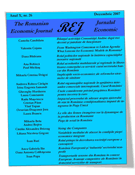Abstract:
The main purpose of the paper is to provide a quantitative and qualitative analysis of state aid policy and its role in ensuring economic development in the EU.Based on theoretical approaches and empirical evidence, it is assumed that an efficient state aid policy should support the macroeconomic stabilization and the economic development. Therefore an econometric model is proposed to evaluate and quantify the relation between the level of horizontal aid and the value of GDP per capita at purchasing power parity standard.According to the results of the analysis, important disparities can be identified in analyzing the correlation between the two indicators mentioned above, deficitary to several EU member states, suggesting the necessity of a better coordination in the economic policies. Thus, one of the most relevant conclusions is that while the general objective of reducing state aid level is mainly achieved since the early 1990s, a redirection of state aid towards horizontal objectives can be observed beginning with 2000 and is still ongoing at present with important consequences for the general economic development of the EU member states.
